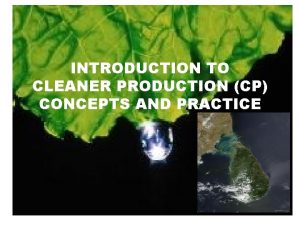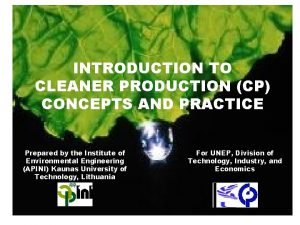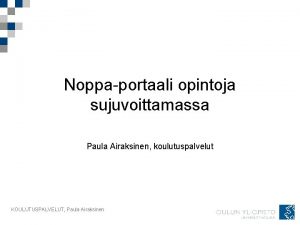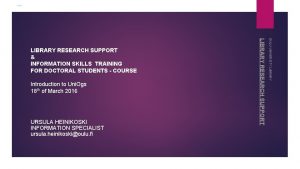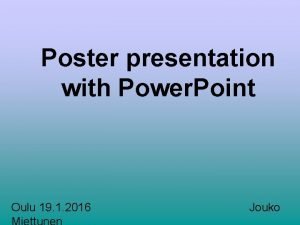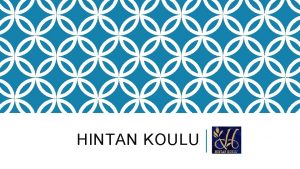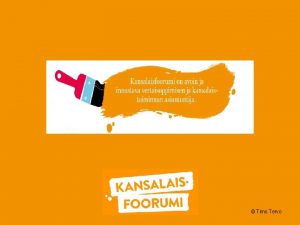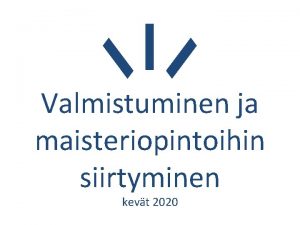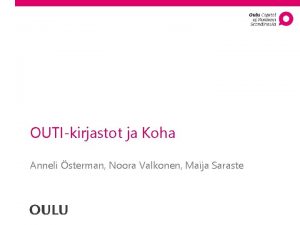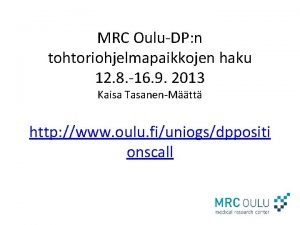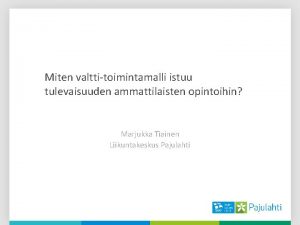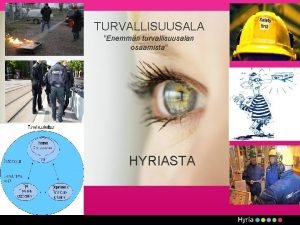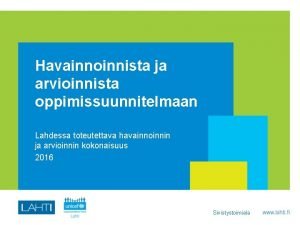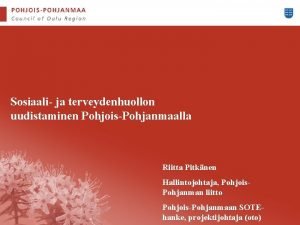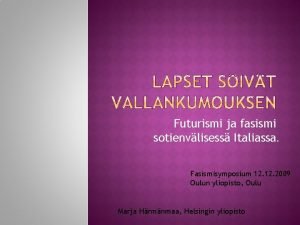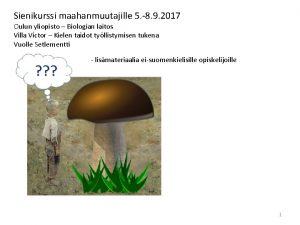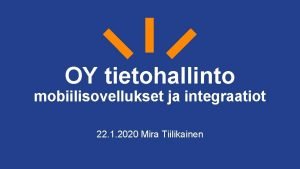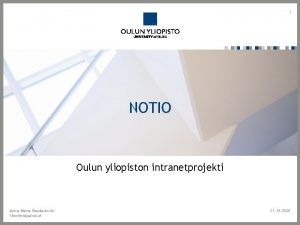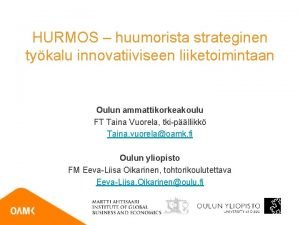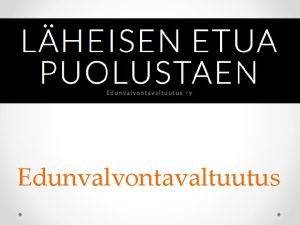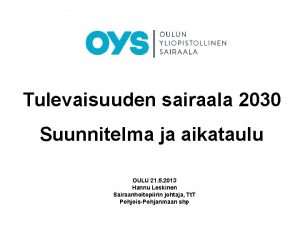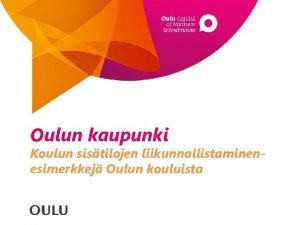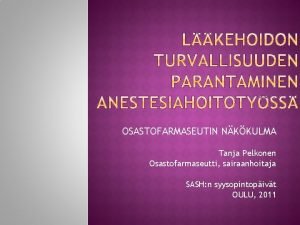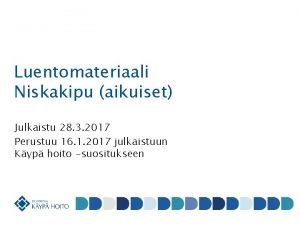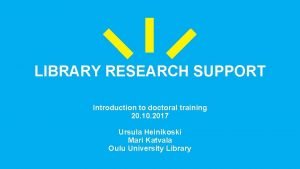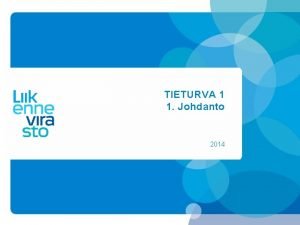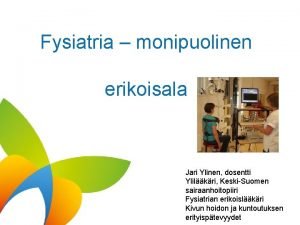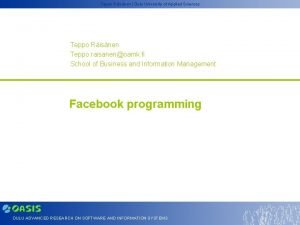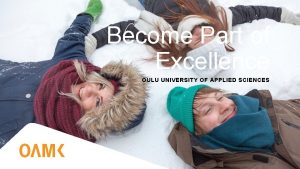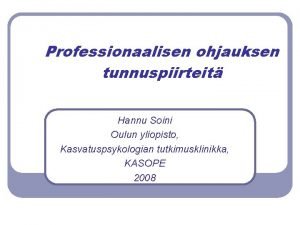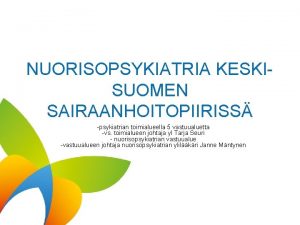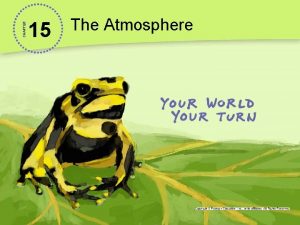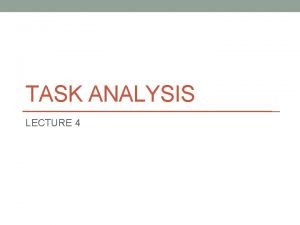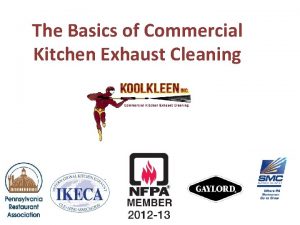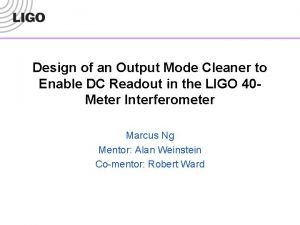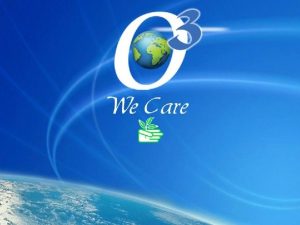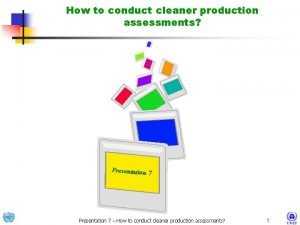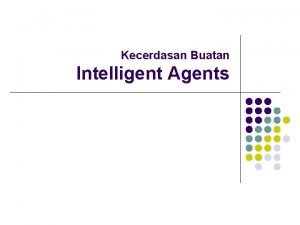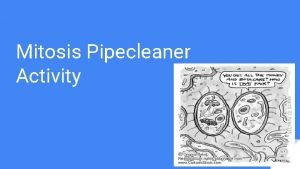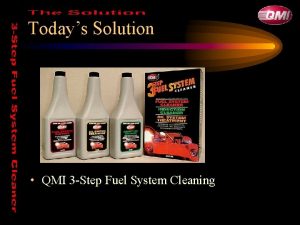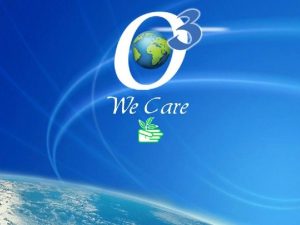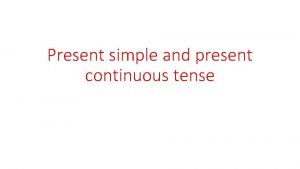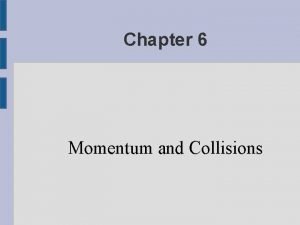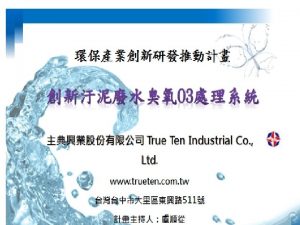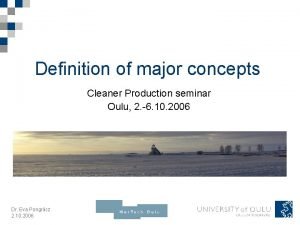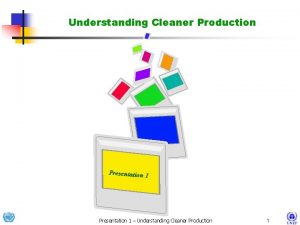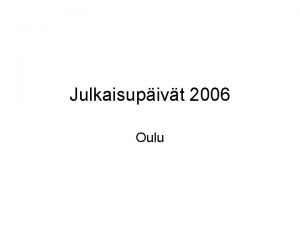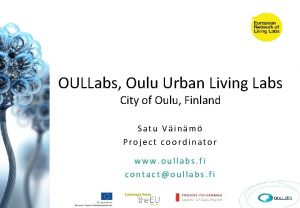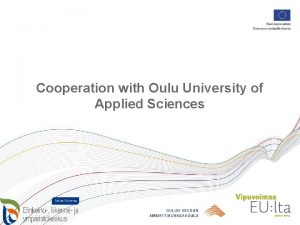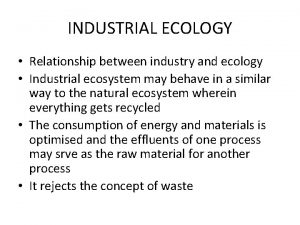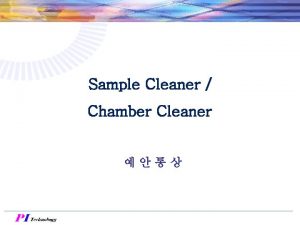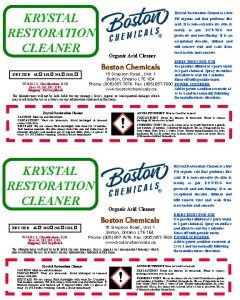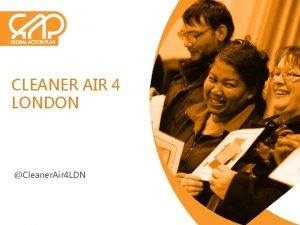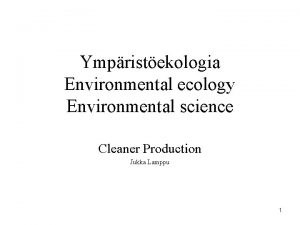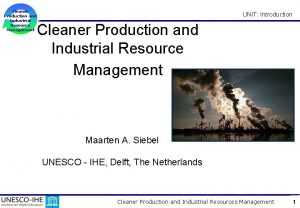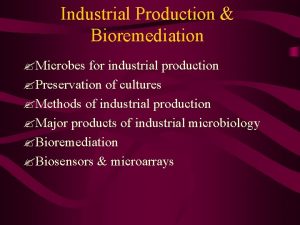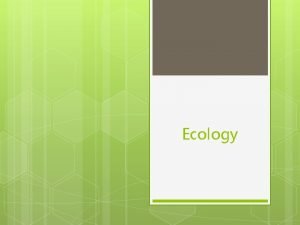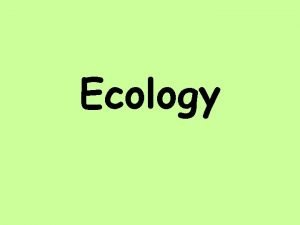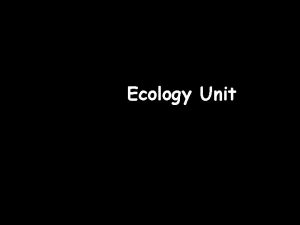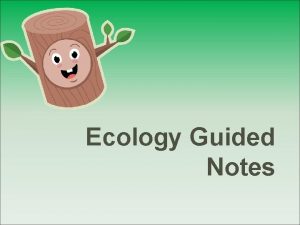Industrial Ecology Cleaner Production seminar Oulu 2 6






















































- Slides: 54

Industrial Ecology Cleaner Production seminar Oulu, 2. -6. 10. 2006 Dr. Eva Pongrácz 6. 10. 2006

2 History of Industrial Ecology • First used in 1970 • 1972: model for structuring the Japanese industrial System – dropped in 1973 • 1989, Frosch and Gallapoulus: industrial systems could be more efficient if material flows modelled after ecosystems. • 1989 -1990: studies on the interrelation between industrial activities vs. environmental impacts. – not necessarily used the term IE – view activities from a systematic basis Dr. Eva Pongrácz 6. 10. 2006

3 What is Industrial Ecology? • A concept of mimicking the natural ecosystem and its efficiency in the use of materials: – the waste of one industry would be raw material of another, – maintain a close cycle of material flows in a society. • Designing man-made ecosystems interfacing with the natural global ecosystem; • A multidisciplinary study of industrial systems, economic activities and their links to natural systems. Dr. Eva Pongrácz 6. 10. 2006

4 Topics in Industrial Ecology • • • Dr. Eva Pongrácz 6. 10. 2006 Material and energy flows studies ("industrial metabolism") Technological change and the environment Life-Cycle planning, design, and assessment Waste management, esp. waste minimization and recycling Design for the Environment Extended producer responsibility ("product stewardship") Eco-industrial parks ("industrial symbiosis") Product-oriented environmental policy Eco-efficiency, dematerialization, decarbonization

5 Entropy • The second law holds that energy is degraded through its use: – it becomes less and less useful to do work. • Entropy is a measure of the state of usefulness of energy: – the lower the entropy of a system, the more work that energy can do. • Example: – think of a home that is heated by a gas furnace. Dr. Eva Pongrácz 6. 10. 2006

6 Role of entropy in explaining environmental problems • The modern industrial system is a transformer of materials and energy: – increasing entropy – reducing the usefulness of materials and energy. • Inefficient use of natural resources. • Solid waste, effluents, emissions, waste heat are measures of the inefficiency Dr. Eva Pongrácz 6. 10. 2006

7 The Concept of a System • System = group of interacting, interrelated elements forming a complex entity. – Needs continual input of materials – Has a constant output of waste materials to dispose of. • Open system = inputs, outputs, interaction • Closed system = minimal interaction with the external environment Dr. Eva Pongrácz 6. 10. 2006

8 A simple system model: Output Input internal relationships Input elements Output Dr. Eva Pongrácz 6. 10. 2006 entity boundary

Open vs. closed systems Dr. Eva Pongrácz 6. 10. 2006 9

10 Industrial Systems • Industrial society uses technology to transform materials to create goods • Industrial technologies include – automated production – mechanical processes – mechanised agriculture • Characteristic: tools are produced by other tools • Indicators: scale and intensity of transformations Dr. Eva Pongrácz 6. 10. 2006

11 Elements of industrial systems • Plants or sites where goods are produced or where supporting functions occur • Linked together through internal relationship – transfers of goods – flows of information • Interact with the broader environment through external relationships. Dr. Eva Pongrácz 6. 10. 2006

12 Linear material flow in Type I ecology Dr. Eva Pongrácz 6. 10. 2006 unlimited ecosystem unlimited resources component waste

13 Quasi-cyclic material flows in Type II ecology ecosystem component energy and limited resources Dr. Eva Pongrácz 6. 10. 2006 limited ecosystem component waste

14 Cyclic material flows in Type III ecology ecosystem component energy Dr. Eva Pongrácz 6. 10. 2006 ecosystem component

15 To move away from Type I • Legislation: consequence of real or perceived environmental crises. • Mode of operation unplanned – imposes economic costs, – may solve one problem only by making other worse • Industrial Ecology: evolution of manufacturing – explaining the interaction of processes and flows – optimising the considerations that are involved. Dr. Eva Pongrácz 6. 10. 2006

16 Characteristics of IE • More than a description of linkages among elements within a system • It is a prescription for the evolution of industrial systems – from a take-and-dump to a closed system • Goals: – long-term sustainability. – transform industry and technology into environmentally benign, – closing the loop between internal metabolism and external environment. Dr. Eva Pongrácz 6. 10. 2006

17 Type III model of the Industrial Ecosystem materials extractor or grower materials processor or manufacturer limited resources limited waste processor Dr. Eva Pongrácz 6. 10. 2006 consumer

18 Natural Metabolism • Metabolism = the internal processes of a living organism. • Inputs: – energy-rich, low-entropy materials • Outputs: – maintenance and functions – a surplus to permit growth or reproduction. – waste outputs, consisting of degraded, high-entropy materials. Dr. Eva Pongrácz 6. 10. 2006

19 Industrial Metabolism • Integrated collection of physical processes in a (more or less) steady-state condition • Inputs: – high-entropy raw materials extracted from Earth – Energy – Labour • Outputs – finished products – wastes • Firm = economic analogue of a living organism in biology. Dr. Eva Pongrácz 6. 10. 2006

20 Biological organisms vs. industrial activities • Analogies – – Materials-processing systems Driven by a flow of free energy Self-organising, dissipative systems in a stable state Far from thermodynamic equilibrium • Major differences between natural and industrial metabolism: – the natural cycles are closed – the industrial cycles are open Dr. Eva Pongrácz 6. 10. 2006

21 More differences: • • • Biological organisms reproduce themselves Firms produce products or services, not other firms. Firms need not be specialised = can change from one product or business to another. Organisms are highly specialised = cannot change their behaviour • – Dr. Eva Pongrácz 6. 10. 2006 except over a long (evolutionary) time period.

22 Closed systems • Closed system = no external sources or sinks • The Earth as a whole is essentially a closed system • A closed system becomes a closed cycle if: – the system is also in steady-state, – the stocks in each compartment are constant and unchanging (at least on the average). • The materials balance condition implies: – inputs to each compartment must be exactly balanced (on the average) by the outputs. Dr. Eva Pongrácz 6. 10. 2006

23 Closed vs. open systems • Closed cycle of flows can be maintained indefinitely only by a continuous flow of free energy – It will last as long as its external energy supply lasts. • An open system, on the contrary, is inherently unstable and unsustainable. It must: – either stabilise – or collapse to a thermal equilibrium state = all flows, that is, all physical and biological processes, cease. Dr. Eva Pongrácz 6. 10. 2006

24 Implications to industrial systems • The natural system is characterised by – closed cycles for the major nutrients (carbon, oxygen, nitrogen, and sulphur) – biological processes play a major role in closing the cycle • The industrial system is an open one – “nutrients” are transformed into “wastes” – which are not significantly recycled. – The industrial system of today is therefore unsustainable Dr. Eva Pongrácz 6. 10. 2006

25 Critical questions: 1. 2. 3. 4. 5. Dr. Eva Pongrácz 6. 10. 2006 Will the industrial system stabilise itself without external interference? If so, how soon, and in what configuration? If not, does there exist any stable state short of ultimate thermodynamic equilibrium that could be reached with the help of a feasible technological “fix”? If so, what is the nature of the fix, and how costly will it be? If not, how long do we have until the irreversible collapse of the bio-geosphere system makes Earth uninhabitable?

26 Evolution of recycling • Result of a several billion years’ long evolutionary process – biological evolution responded to inherently unstable open systems – inventing new processes to stabilise the system by closing the cycles. • “Recycling organisms” close the natural cycles of major elements. • To complete the industrial metabolism, we also need to develop recycling technologies – enable us to cycle material within industrial ecosystems efficiently. Dr. Eva Pongrácz 6. 10. 2006

27 Measures of Industrial Metabolism • There are only two possible long-run fates for waste materials: – recycling and reuse – dissipative loss. • The more materials are recycled, the less will be dissipated into the environment, and vice versa. • Dissipative losses must be made up by replacement from virgin sources. Dr. Eva Pongrácz 6. 10. 2006

28 Classes of materials use 1. 2. 3. Dr. Eva Pongrácz 6. 10. 2006 Uses that are economically and technologically compatible with recycling under present prices and regulations. Uses that are not economically compatible with recycling but where recycling is technically feasible, for example, if the collection problem were solved. Uses for which recycling is inherently not feasible.

29 Sustainable economy characteristics • Near-total recycling of intrinsically toxic or hazardous materials, • A significant degree of recycling of materials whose disposal constitutes an environmental problem. • Heavy metals are among the materials that would have to be almost totally recycled to satisfy the sustainability criterion. Dr. Eva Pongrácz 6. 10. 2006

30 Realising Industrial Ecology in practice • Apply the laws of thermodynamics and systems theory to the problem of natural resource scarcity leading to: – a reduced need for materials and energy, – cycling of these inputs withine (internal) industrial process, – limited deposition (output) of products and by-products. • Industrial systems would evolve to a stage where their design and functioning would mimic recycling of matter and energy in natural ecosystems. – Closed loop of resource extraction production consumption waste disposal Dr. Eva Pongrácz 6. 10. 2006

31 Limits to recycling • Materials complexity - difficulty of separating materials into recyclable components; – e. g. plastics, multimaterials • Dissipative use - difficult to recover – Toxic materials – high priority for recycling! • Limited capacity of most economies to absorb recycled material. – Economies were designed to use virgin materials • No major reductions in materials use - there was no intent to do so – “end-of-pipe” recycling; lightweighting for economic reasons • Need to re-think of the structure and purpose of modern economies Dr. Eva Pongrácz 6. 10. 2006

32 Industrial Symbiosis • Symbiosis – living together of two dissimilar organisms in any of various mutually beneficial relationships. • Industrial symbiosis (clustering) – method based on the principles of Industrial Ecology. – internalises environmental costs within production and consumption processes. • Eco-industrial parks – take advantage of outputs of co-located operations – exchanging wastes for 'raw' materials Dr. Eva Pongrácz 6. 10. 2006

33 Trading by-products • Industrial ecosystems – extension of life cycle thinking: moving from assessment to implementation. • Closing loops – – use of recycled materials in production optimising use of materials and embedded energy minimising waste generation re-evaluating “wastes” as raw material for other processes. • Companies – – – Dr. Eva Pongrácz 6. 10. 2006 create complex networks of material flows develop sets of linkages throughout their operations increase the efficiency of material and energy throughput. capture emissions and wastes recycle them back into processes as inputs.

34 Kalundborg Participate enterprises : 1. Asnæs Power Station, 2. GYPROC plasterboard manufacturer, 3. Novo Nordisk/Novozymes pharmaceutical and biotechnology company, 4. A/S Bioteknisk Jordrens soil remediating company 5. STATOIL refinery • Material and energy flows – – Dr. Eva Pongrácz 6. 10. 2006 Steam and heat Water Sludge Refinery gas – – Gypsum Biomass Liquid fertilizer Fly ash

35 How the by-products are used ? Steam and heat • Asnæs Power Station – heat for the town of Kalundborg – process steam for the STATOIL Refinery – process steam for Novo Nordisk/Novozymes. • District heat – 4, 300 households in Kalundborg receive district heat from Asnæs Power Station. – replaced approx. 3, 500 small oil-fired units. • Steam – Statoil refinery uses for heating oil tanks and pipelines – Novo Nordisk/Novozymes uses for heating and sterilisation purposes. • Cooling water – Fish farm= 200 tonnes of trout a year. Dr. Eva Pongrácz 6. 10. 2006

36 Water • Asnæs Power Station – reduce its total water consumption by 60 per cent. – surface water from lake Tissø – cooling water and treated waste water from Statoil Refinery. • Reduced ground water its consumption by 90 %. Sludge • Major residual from the public water treatment plant in Kalundborg. – utilised at A/S Bioteknisk Jordrens – nutrient in the bioremediation process. Dr. Eva Pongrácz 6. 10. 2006

37 Refinery gas • “eternal” flare of surplus gas – – part of the safety system at all refineries. STATOIL reduced the flare to a night-light internal re-use Asnæs Power Station use the surplus refinery gas as fuel instead of coal and oil Gypsum • Asnæs Power Station’s FGD – removes SO 2 from the flue gas – produces about 200, 000 tonnes of gypsum a year. – sold to GYPROC, which makes plasterboard products for the building industry – more uniform and cleaner Dr. Eva Pongrácz 6. 10. 2006

38 Biomass • Enzyme production – based on fermentation of potato flour and corn starch. – produces about 97. 000 m 3 solid biomass (Novo. Gro/30) – 280. 000 m 3 liquid biomass (Novo. Gro) • Biomass – contains N, P and lime – piped or transported by tanker to farmers – use it to fertilise their fields, – reducing their need for fertilisers. • Surplus yeast – insulin production – used as animal feed. Dr. Eva Pongrácz 6. 10. 2006

39 Liquid fertilizer • STATOIL – – removes SO 2 from the flue gas ammoniumthiosulphate a major by-product. used in the production of liquid fertiliser 20. 000 t/year = Danish annual consumption. Fly ash • Asnæs Power Station – – Dr. Eva Pongrácz 6. 10. 2006 electro-filtration unit removes ash from the flue gas fly ash 70. 000 t/year used in the building industry most of it goes to Aalborg Portland - cement production.

40 Dr. Eva Pongrácz 6. 10. 2006

41 Advantages of the symbiosis • Reduced consumption of resources – e. g. water, coal, oil, gypsum, fertiliser, etc. • Reduced environmental impact – in the form of smaller emissions of CO 2 and SO 2, – smaller discharge of waste water and less pollution of water courses etc. • Better utilisation of energy resources. – Waste gases are used in the energy production process. • Financially gain from the co-operation – all contracts within the symbiosis based on sound commercial principles. Dr. Eva Pongrácz 6. 10. 2006

42 Criteria for symbiosis: • The enterprises must function together – Waste products from one enterprise must fit the need of other enterprises in order to turn waste products into raw materials. – Diversity is a necessary precondition. • The enterprises must be situated near each other – Long pipelines are costly: the greater the length, the greater the energy losses. • Openness between the enterprises – At Kalundborg the decision makers all know each other – relationship characterised by openness, communication and mutual trust. Dr. Eva Pongrácz 6. 10. 2006

43 Chaparral Steel Company • Produces bar and structural steel products by recycling scrap steel. • The primary source of scrap steel is old automobiles. – Automobile shredder facility located next to the mill. • Scrap is melted by electric arc furnaces (EAFs) – complemented by two ladle furnaces • Wastes and by-products – EAF slag – mill scale - sold to Portland cement, source of iron oxide – – Dr. Eva Pongrácz 6. 10. 2006 producers baghouse dust auto shredder residue non-ferrous particulate spent refractories

44 STAR project Systems and Technology for Advanced Recycling • Synergy between the steel and cement manufacturing processes and the automobile shredding facility – all located in Midlothian, TX • ”Company, know thy waste” – To be able to manage, you need to measure. • Mapping to identify process steps and requirements relationships plant-wide • Material re-use and pollution reduction saves millions of dollars annually. Dr. Eva Pongrácz 6. 10. 2006

45 The Cem. Star Process • Adds slag to the cement raw material mix – Type I Portland cement – Previously slag was cooled, crushed, and sold to the road construction industry. • Slag magnetic separation process recovers metals and recycles back to the furnace • The lower-grade iron slag is fed into the cement plant kilns substitute for limestone. • Results – Reducing energy requirements 10 -15%. – The value of the slag is increased 20 times – Reduced CO 2 production from the cement-making process. Dr. Eva Pongrácz 6. 10. 2006

46 By-product Synergy for Automobile Shredder Residue • 700, 000 obsolete cars are shredded yearly • 180, 000 tons of residue, generally landfilled – aluminium, magnesium, glass, PVC, rubber – non-chlorinated plastics – non-ferrous metals. • Automobile Scrap Residue cleaning system – eddy current technology – flotation separation technology – Recovers Al, Mg, plastics • Sale of plastics alone generates up to $500, 000 a year Dr. Eva Pongrácz 6. 10. 2006

47 Florida Power & Light • Central Reclamation and Salvage Department – processes scrap wire and cable and recovers waste • Porcelain (old insulators and electric equipment) – crushed and sold to road builders. • Damaged pallets, dunnage, and old spools – local sugar mill burn the wood in boilers to provide process steam – usable wood poles are donated to local farmers for fencing. • Scrap wire insulation – fuel for the solid waste authority through burning. • Used stretch wrap – utilized for plastic lumber product. • Wire reels – returned to manufacturers for re-use. • PVC, PE and PC – cleaning, granularising, recycle. • Al and Cu wiring harvested and sold Dr. Eva Pongrácz 6. 10. 2006

The STAR synergy Dr. Eva Pongrácz 6. 10. 2006 48

49 Eco-Farming in Fiji • Integrated farming – using the waste of one agricultural industry as fertiliser or fuel for another – little or no pollution into the environment. • Starting point: sludge from a large Fijian brewery – – – mushrooms chicken Fish Vegetables fuel for electric power. • The site of the experiment – ‘Montfort Boys' Town a school for disadvantaged boys‘ • Fiji – Poor – established fish-farming industry – signs that sugar industry could go into a serious decline Dr. Eva Pongrácz 6. 10. 2006

50 Dr. Eva Pongrácz 6. 10. 2006

51 Industrial Ecology in Jyväskylä • Rauhalahti power plant – electricity and heat to local households, buildings, services and industry – residual steam to Kangas paper mill • Paper mill – hot water to local greenhouse horticultural centre Greenlandia 12 • Plywood mill – – – waste of wood leftovers to power plant with the. receives electricity in turn. utilise the wood leftovers in a sub- urban boiler plant provides the plywood mill with process steam heat to the nearby households and buildings • Power plant: – waste ash to green construction – "Green Land" project - model for green gardening Dr. Eva Pongrácz 6. 10. 2006

The Jyväskylä ecosystem Dr. Eva Pongrácz 6. 10. 2006 52

53 The gains of Industrial Ecology in Jyväskylä • The consumption of heavy fuel oil has decreased – 963 GWh in 1980 122 GWh in 1997. • The SO 2 emissions have decreased – 3700 tonnes in 1980 1700 tonnes in 1997. • Covers over 90 % of the heating energy demand of the city of Jyväskylä. – The use of imported coal and oil fuels has decreased considerably. Dr. Eva Pongrácz 6. 10. 2006

54 Summary on Eco-Industrial Development • IE is about the beneficial integration of all resources. • Materials flow is at the core of IE as a way to reduce cost, toxicity and net volume within business operations. • Different organisations expend different proportions of their budgets in the purchase and processing of materials. • There are possibilities of overlapping purchases when various materials are common to a number of companies. • While pipe-to-pipe connections are desirable, they are not always possible. • There is a need to examine intermediate strategies to facilitate a larger range of materials connections that meet time, quality and quantity requirements. Dr. Eva Pongrácz 6. 10. 2006
 Jelaskan 3 proses alur produksi multimedia
Jelaskan 3 proses alur produksi multimedia Cleaner production principles
Cleaner production principles Cleaner production principles
Cleaner production principles Yale industrial ecology
Yale industrial ecology Noppa oulu
Noppa oulu Solecris oulu
Solecris oulu Posterin teko
Posterin teko Hintan koulu
Hintan koulu Skafnet
Skafnet Sternoklavikulaari
Sternoklavikulaari Pateniemen koulu
Pateniemen koulu Oulu ktk valmistuminen
Oulu ktk valmistuminen Outikirjastot oulu
Outikirjastot oulu Mrc oulu
Mrc oulu Juha tiainen oulu
Juha tiainen oulu Lappeenrannan seurakunta
Lappeenrannan seurakunta Valjento lahti
Valjento lahti Uniogs lomakkeet
Uniogs lomakkeet Riitta pitkänen oulu
Riitta pitkänen oulu Ervo oulu
Ervo oulu Sienikurssi oulu
Sienikurssi oulu Oulu university of applied sciences
Oulu university of applied sciences Mira tiilikainen
Mira tiilikainen Notio oulu
Notio oulu Hurmos oulun yliopisto
Hurmos oulun yliopisto Kirjasto oulu
Kirjasto oulu Edunvalvontavaltuutuslaki
Edunvalvontavaltuutuslaki Potilashotelli oulu
Potilashotelli oulu Metsälinnan päiväkoti
Metsälinnan päiväkoti Oulun digitarvike
Oulun digitarvike Tanja pelkonen oulu
Tanja pelkonen oulu Selkärankareuma niskakipu
Selkärankareuma niskakipu Oulu university library
Oulu university library Tieturvakoulutus lahti
Tieturvakoulutus lahti Fysiatrian poliklinikka oulu
Fysiatrian poliklinikka oulu Teppo räisänen
Teppo räisänen University of oulu bachelor
University of oulu bachelor Hannu soini
Hannu soini Nuorisopsykiatrian poliklinikka oulu
Nuorisopsykiatrian poliklinikka oulu Industrial production index formula
Industrial production index formula Charging toward cleaner air in london
Charging toward cleaner air in london Administrativia
Administrativia Commercial kitchen exhaust cleaning philadelphia pa
Commercial kitchen exhaust cleaning philadelphia pa Mode cleaner
Mode cleaner What is peas in ai
What is peas in ai Glove cleaner potion
Glove cleaner potion Green coil cleaner
Green coil cleaner Conduct
Conduct Peas for vacuum cleaner agent
Peas for vacuum cleaner agent Procare citrus floor cleaner lowe's
Procare citrus floor cleaner lowe's Pipe cleaner mitosis
Pipe cleaner mitosis Qmi fuel treatment
Qmi fuel treatment Alkaline coil cleaner
Alkaline coil cleaner Window cleaner
Window cleaner An 85 kg fisherman jumps from a dock
An 85 kg fisherman jumps from a dock

